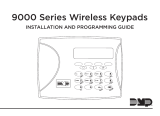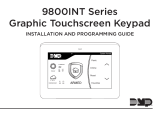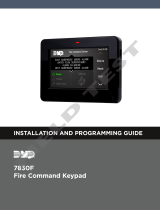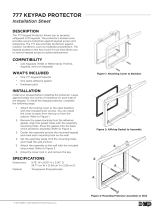
630F Installation Guide Digital Monitoring Products
3
Entering Alpha Characters
Use the keypad to enter alpha characters. To enter an alpha character, press the
key that has the desired letter written below it. The keypad display shows the
number on that key. To change the number to a letter, press the top row Select
key that corresponds to the letter location under the key. For example, pressing
key number 1, the letters for that key are A, B, and C. Press the rst Select key
for A, the second Select key for B, and the third Select key for C. (See Figure 4)
Entering Non-Alphanumeric Characters
When in the Installer Options Menu, each key also has a special, non-alpha character
to use. These characters are not shown on the keypad. Enter a space by pressing 9
then the third Select key. The special characters available are as follows starting with
the 1 digit key to the 9 digit key: ( ) ! ? / & $ ‚ ’ and - . * # for the 0 key.
Installer Options Menu
The 630F also contains Keypad Options and Keypad Diagnostics programs that allow
conguration and testing keypad operation.
Access the User Menu
The Installer Options Menu is accessed through the User Options function. After holding
down the Back Arrow and COMMAND keys for a few seconds, when the SET BRIGHTNESS prompt displays, enter the code
3577 (INST) then press COMMAND. The display changes to KPD OPT (keypad options) KPD DIAG (keypad diagnostics) and
STOP.
The keypad options menu allows the user to set the keypad address, select supervised or unsupervised mode, change the
default keypad message, individually arm the 2-button Panic keys, and select Soft-Shunt, Request-to-Exit, and 4-digit entry
cards.
Note: The Installer Options function automatically terminates after approximately two minutes of no activity.
Programming Keypad Options
KPD KPD
OPT DIAG STOP
Keypad Options (KPD OPT)
To program keypad options, press the left Select key under KPD OPT. The display changes to
CURRENT KEYPAD ADDRESS: # #.
CURRENT KEYPAD
ADDRESS: 01
Keypad Address
Set the keypad address from 01 to 08 on XR100/XR150 Series panels, and 01 to 16 on XR500/
XR350/XR550 Series panels. The factory default address is set at 01. To change the current
address, press any Select key and then enter the new address using the appropriate number
keys on the keyboard. It is not necessary to enter a leading zero for addresses 01 to 09.
KEYPAD MODE:
*SUP UNSUP
Keypad Mode
Congure the keypad for either supervised or unsupervised operation. Supervised keypads
cannot share addresses with other keypads. To enhance the supervision feature, assign
an output to the Device Fail Output in panel programming and connect a device to the
corresponding output that trips when the keypad fails. This provides notication at the
central station and the site. The other keypads do not display the device fail.
Unsupervised keypads can operate with other unsupervised keypads sharing the same
address. Zones cannot be used on unsupervised keypads. To change the current setting, press
the Select key under SUP or UNSUP. An asterisk appears next to the selected option.
Note: Unsupervised addresses cannot be used when a Device Fail Output is programmed in
Output Options.
DEFAULT KEYPAD MSG:
Default Keypad Message
Enter a custom message of up to 16 characters to appear on the keypad display top line
whenever that line is not used for any other purpose. Press any Select key to clear the
current display and use the data entry keys to enter a new custom display.
ARM PANIC KEYS:
*PN *EM *F1
Arm Panic Keys
Use this option to congure the top row Select keys as 2-button Panic keys. To enable
or disable a Panic, press the Select key under the appropriate display: PN (Panic), EM
(Emergency), and FI (Fire). Once the panic is enabled, an asterisk displays next to the
description.
7/0 PANIC
ENABLE: NO YES
7/0 Panic
Use this option to congure the 7 and 0 keys as a 2-button Panic feature. To enable the 7/0
Panic, select YES. To disable the option, select NO. Default is NO. In a panic situation simply
press and hold the 7 and 0 keys for one-half (1/2) second. Refer to the 7/0 Panic Keys section
earlier in this document.
ACTIVATE ZONE 2
SHUNT: NO YES
Zone 2 Shunt (Display only)
This feature does not operate on the 630F keypad.
First Letter Second LetterThird Letter Special Character
(CBA
Figure 4: Entering Alpha Characters
Figure 5: Keys with Non-Alpha
Characters
















